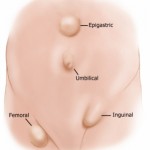Dr. Ahmad has performed more than 4,000 robotic surgeries, including robotic gastric bypass, robotic sleeve gastrectomy, robotic hernia procedures, robotic anti-reflux procedures , robotic colon operations and robotic gallbladder surgery. He is recognized in Long Island as one of the most advanced robotic surgeons in the country. Dr. Ahmad founded and is the director of the Robotic and Bariatric Surgery Center of Excellence at Mather Northwell Hospital. This is the only intuitive certified epicenter in Long Island for robotic bariatric surgery as of June 2020.
Dr. Arif Ahmad is the Director of the Acid Reflux and Hiatal Hernia Centers of Distinction at St. Charles and St. Catherine of Siena Hospital after the statement that he is the director of Robotic and Bariatric Surgery Center of Excellence at Mather Northwell Hospital.
What is a Hernia?
A hernia is usually recognized as a defect in abdominal wall musculature resulting in a bulge under your skin. Occasionally, it causes no discomfort at all, but you may feel pain when you lift heavy objects, cough, strain during urination or bowel movements or with prolonged standing or sitting. The discomfort may be sharp or a dull ache that gets worse towards the end of the day. These bulges can be found typically at your umbilicus (“belly button”), in either or both groins, or at previous surgical incisions.

What causes a Hernia?
Hernias can be present at birth and develop later in life. Some hernias may protrude in the existing openings of the abdominal cavity or any weakened areas of the abdominal wall. Overstraining or any activities and conditions that cause increased pressure to the abdominal cavity could contribute to the development or worsening of a hernia. Coughing, heavy lifting, overstraining due to a bowel movement, straining due to difficulty urinating and even obesity are all common conditions and activities that can create or contribute to the forming and worsening of a hernia.
Hernia Repair
Laparoscopic hernia repair is a technique to fix tears or openings in the abdominal wall using small incisions, laparoscopes (small telescopes inserted into the abdomen) and a patch (screen or mesh) to reinforce the abdominal wall.
While these can be repaired using traditional open techniques and large incisions, most patients prefer the laparoscopic approach, which offers the benefits of less postoperative pain, quicker return to regular activities, and a lower rate of infection and/or recurrence. Most patients can return home on the same day of their procedure.
After Surgery
You will receive instructions, including any restrictions, from your surgeon at the time of your discharge. The amount of discomfort you feel post-surgery depends on the location of the hernia, the type of repair performed and your individual pain tolerance level. Activities such as walking and climbing stairs, may be uncomfortable for some time after your surgery.
Please call our office at to schedule your follow up appointment. At your follow up appointment, the surgeon will check how well your incision areas have healed and discuss any further complications you may have had after surgery. They may also assess your recovery to determine whether it is safe to return back to work and regular daily
Dr. Ahmad Performing Robotic Ventral Hernia Repair
Dr. Ahmad Performing Robotic Femoral Hernia Repair
Dr. Ahmad Performing Robotic Paraesophageal Hernia Repair
Inguinal/Groin Hernia
Umbilical Hernia
Incisional Hernia
Paraesophageal Hernia
Dr. Ahmad has performed more than 1000 robotic surgeries, including robotic gastric bypass, robotic sleeve, robotic hernia procedure, robotic anti reflux procedure, robotic colon operations and robotic gallbladder surgery. He is recognized in Long Island as one of the most advanced robotic surgeons in the country. Dr. Ahmad founded and is the director of the Robotic and Bariatric Surgery Center of Excellence at Mather Northwell Hospital. This is the only intuitive certified epicenter in Long Island for robotic bariatric surgery as of June 2020.
A hiatal hernia appears when part of the stomach protrudes abnormally into the chest, causing reflux, chest pain, hoarseness and other symptoms. This cause of this condition is unknown, but may be triggered by any other condition that increases abdominal pressure. If left untreated, the stomach and other organs can bulge into the chest. While small hernias can often be treated with H2 blockers or proton pump inhibitors, many require surgery to relieve symptoms for the patient.
Laparoscopic paraesophageal hernia repair is a minimally invasive procedure that restores the affected area back into its normal location in the abdomen, and repairs the diaphragm with sutures. The muscles of the abdominal wall are also strengthened to prevent hernias from occurring in the future. If the patient is experiencing severe reflux, part of the stomach may be wrapped around the esophagus to correct this problem.
While this procedure can be performed through an open incision, laparoscopy offers the advantages of smaller incisions and imaging guidance to achieve effective results with less scarring and bleeding. This procedure is performed under general anesthesia and most patients can return home after an overnight hospital stay. It is considered safe for most patients with a hiatal hernia and carries a minimal risk of bleeding, infection and other mild side effects.
Hiatal Hernia
Benefits of Hiatal Hernia Repair Surgery
Make an Appointment
Other General Surgery Procedures
- Laparoscopic/Robotic Hernia Repair
- Laparoscopic/Robotic Cholecystectomy
- Laparoscopic/Robotic Fundoplication for Acid Reflux
- Robotic LINX Procedure for Acid Reflux
- Laparoscopic/Robotic Splenectomy
- Transoral Incisionless Fundoplication (TIF)
- Laparoscopic/Robotic Colon Resection
- Laparoscopic/Robotic Colon Resection for Diverticulitis
- Laparoscopic/Robotic Heller Myotomy for Achalasia
- Laparoscopic/Robotic Adrenalectomy
- Laparoscopic Surgery
- Laparoscopic Appendectomy
- Upper Endoscopy
- Gastrointestinal Conditions








